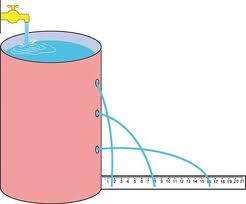When we turn on the kitchen tap or run a bath we may not be thinking how the water is coming out, unless it is dripping or not coming out at all! But, water pressure is something that we should all be familiar with.
Most households receive water from a municipal water system where the water is usually extracted from groundwater sources and then treated for human consumption. Then it is pumped to water towers and from there gravity takes over to provide the pressure that forces the water through pipes and into our homes.
The pressure of water in each home will vary according to their elevation to the water source, as well as with the system that is delivering the water in. A plumbing company website says, “A cubic foot of water weighs 62.4 lb. and exerts .4333 lbs of pressure per square inch on the bottom of its container at a depth of one foot. Therefore, the discharge pressure of a water storage tower 100 ft. tall will be 43.33 psi. If your house is in a valley 50 ft. below the bottom of the tower, the theoretical water pressure at your house will be approximately 65 psi, reduced by the friction in the pipes.”
Click here for a handy pressure conversion tool: http://www.sensorsone.co.uk/pressure-units-conversion.html
Typical residential water systems are designed to function under a pressure of 40-70 psi. If the water pressure exceeds 100 psi a pressure regulator may need to be installed in the line to reduce the pressure to an acceptable range. This protects the equipment in your home from damage caused by excess force exerted by the water. The opposite can occur too, if pressure is below 40 psi a pressure-booster could be needed to bring it up to acceptable levels. Note also that hard water can reduce pressure.
It is also important to note that water flow is not the same thing as water pressure. Water flow is the result of your water pressure on the amount of water available for delivery (volume). Low water flow could be a result of an obstruction on the water line. An old pipe can contain mineral build-up or corrosion that reduces the pipe’s internal diameter. So if a water pressure gauge is reading at an acceptable level but the pressure seems off, it may be a flow problem.
If you are unsure of the water pressure at your home you can easily test it with a simple water pressure gauge available from your local plumbing merchant, or you can ask your plumber/DIY friend to check it
The term “High pressure” when used to describe residential home water supply generally means a minimum of 1.0 bar water pressure. This can be achieved by using one of the following systems:
– Combination boiler systems
– Gravity fed systems (only with a pump)
– Megaflow system
– Pumped hot water systems
– Un-vented hot water systems
– Standard pressurized hot water cylinder type systems
Need some help working out what kind of water pressure system you have? Try answering these questions:
Do you have a cold water tank in your loft feeding your hot water cylinder?
Yes = You probably have a low pressure water system which means you should choose from our selection of low pressure taps
No = Do you have a hot water cylinder elsewhere?
Yes = You probably have a low pressure water system which means you should choose from our selection of low pressure taps
No = You probably have a high pressure system which means you can choose from any of our bathroom and kitchen taps and mixers


Great info!